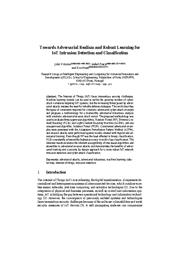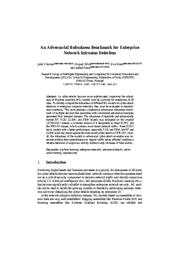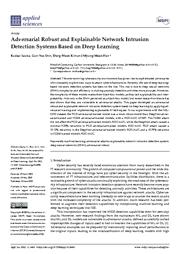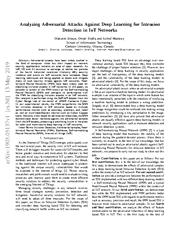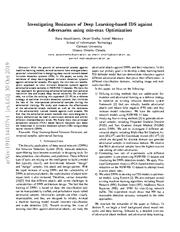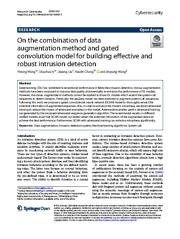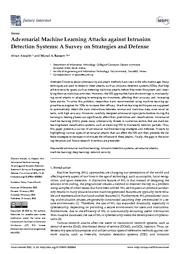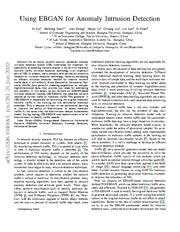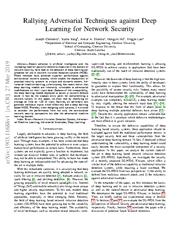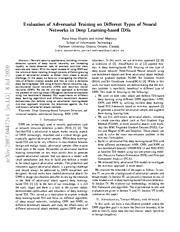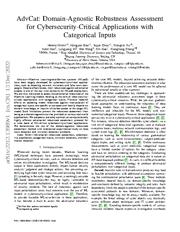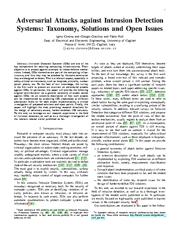A copy of this work was available on the public web and has been preserved in the Wayback Machine. The capture dates from 2024; you can also visit the original URL.
The file type is application/pdf.
Filters
A Hierarchical Deep Learning Architecture for Robust Intrusion Detection in Time-Evolving Security Landscapes
2024
International Journal for Research in Applied Science and Engineering Technology
Abstract: This paper introduces a novel architecture for Intrusion Detection Systems (IDS), designed to enhance resilience against adversarial attacks by integrating conventional machine learning (ML) ...
This fusion mechanism effectively combines the strengths of DL and ML models, thereby bolstering the overall robustness of the IDS against sophisticated intrusion attempts. ...
Adversarial attacks targeting intrusion detection systems continue to evolve, and sophisticated adversaries may exploit vulnerabilities in the model to generate adversarial examples that evade detection ...
doi:10.22214/ijraset.2024.58300
fatcat:csc3ff2mobfprhcuxilhxhnf54
Towards Adversarial Realism and Robust Learning for IoT Intrusion Detection and Classification
[article]
2023
arXiv
pre-print
approach for a more robust IoT network intrusion detection and cyber-attack classification. ...
Machine learning models can be used to tackle the growing number of cyber-attack variations targeting IoT systems, but the increasing threat posed by adversarial attacks restates the need for reliable ...
To determine the most adequate ML models for IoT network intrusion detection, it is important to understand the results and conclusions of previous performance evaluations. ...
arXiv:2301.13122v2
fatcat:y75tbjbsznfgldxttahjppntea
An Adversarial Robustness Benchmark for Enterprise Network Intrusion Detection
[article]
2024
arXiv
pre-print
To reliably compare the robustness of different ML models for cyber-attack detection in enterprise computer networks, they must be evaluated in standardized conditions. ...
Overall, the robustness of the models to adversarial cyber-attack examples was improved without their generalization to regular traffic being affected, enabling a reliable detection of suspicious activity ...
In the network intrusion detection domain, ML models based on ensembles of decision trees are very well-established. ...
arXiv:2402.16912v1
fatcat:t2autketkreprngqipxmjrrpva
Adversarial Robust and Explainable Network Intrusion Detection Systems Based on Deep Learning
2022
Applied Sciences
This paper developed an adversarial robust and explainable network intrusion detection system based on deep learning by applying adversarial training and implementing explainable AI techniques. ...
This rise is due to deep neural networks (DNN) complexity and efficiency in making anomaly detection activities more accurate. ...
Acknowledgments: We would like to appreciate UCI Knowledge Discovery in Databases Archive (https://kdd.ics.uci.edu/) for their effors for providing clear explanation of KDD99 dataset. ...
doi:10.3390/app12136451
fatcat:i7psuqjdtnf4higd2uo5r3f2qy
Analyzing Adversarial Attacks Against Deep Learning for Intrusion Detection in IoT Networks
[article]
2019
arXiv
pre-print
However, when tested for adversarial robustness, the SNN demonstrates better resilience against the adversarial samples from the IoT dataset, presenting a promising future in the quest for safer and more ...
Deep learning techniques are being applied to detect and mitigate many of such security threats against IoT networks. ...
did not evaluate the adversarial robustness of their machine learning models in their study. ...
arXiv:1905.05137v1
fatcat:r7x5slaqbnfynajwiix46f4r4y
Investigating Resistance of Deep Learning-based IDS against Adversaries using min-max Optimization
[article]
2019
arXiv
pre-print
We apply the min-max (or saddle-point) approach to train intrusion detection systems against adversarial attack samples in NSW-NB 15 dataset. ...
With the growth of adversarial attacks against machine learning models, several concerns have emerged about potential vulnerabilities in designing deep neural network-based intrusion detection systems ...
INTRODUCTION The Security applications of deep neural networks (DNNs) like Intrusion Detection System (IDS), malware detection, spam-filtering have become essentials in designing tasks for data protection ...
arXiv:1910.14107v1
fatcat:evhwk4ismvazfkj565ocatciuy
On the combination of data augmentation method and gated convolution model for building effective and robust intrusion detection
2020
Cybersecurity
Also, in order to enhance the model's robustness, we adopt adversarial training to reduce the impact of adversarial examples on the model. ...
AbstractDeep learning (DL) has exhibited its exceptional performance in fields like intrusion detection. ...
Adversarial training is a method that combines the original legitimate samples and adversarial samples to retrain the model, which can improve the robustness of the model. ...
doi:10.1186/s42400-020-00063-5
fatcat:foakfaojyvfb5ipsg6cuj2hm64
Adversarial Machine Learning Attacks against Intrusion Detection Systems: A Survey on Strategies and Defense
2023
Future Internet
Adversarial machine learning (AML) poses many cybersecurity threats in numerous sectors that use machine-learning-based classification systems, such as deceiving IDS to misclassify network packets. ...
Many techniques are used to detect or deter attacks, such as intrusion detection systems (IDSs), that help achieve security goals, such as detecting malicious attacks before they enter the system and classifying ...
to detect suspicious network intrusion. ...
doi:10.3390/fi15020062
fatcat:sy3higzxfjatbgrcnpx6kiyg5i
Using EBGAN for Anomaly Intrusion Detection
[article]
2022
arXiv
pre-print
This is because we want to use adversarial learning to improve the ability of discriminator to detect malicious traffic. At the same time, the discriminator adopts Autoencoder model. ...
As an active network security protection scheme, intrusion detection system (IDS) undertakes the important responsibility of detecting network attacks in the form of malicious network traffic. ...
Adversarial training is a powerful method to enhance the robustness of neural networks.
B. Energy-based Generative Adversarial Networks GANs were introduced by Goodfellow et al. in 2014 [8] . ...
arXiv:2206.10400v1
fatcat:igli4scnnzfoxbuj4jjfyvto4a
The Threat of Adversarial Attacks on Machine Learning in Network Security – A Survey
[article]
2023
arXiv
pre-print
This is because machine learning applications in network security such as malware detection, intrusion detection, and spam filtering are by themselves adversarial in nature. ...
We conclude by introducing an adversarial risk grid map and evaluating several existing adversarial attacks against machine learning in network security using the risk grid map. ...
They also demonstrated that adversarial training was effective in improving the robustness of deep learning based network intrusion detection systems. D. ...
arXiv:1911.02621v3
fatcat:vc6g4mckrzcardykunzsxb6kfa
Rallying Adversarial Techniques against Deep Learning for Network Security
[article]
2021
arXiv
pre-print
intrusion detection systems. ...
Because of this susceptibility, the deep learning models deployed to power a network defense could in fact be the weakest entry point for compromising a network system. ...
EVALUATED NETWORK In this section, we present a brief overview of the network intrusion detection system and then analyze the Kitsune's deep learning model, KitNET, in more detail.
A. ...
arXiv:1903.11688v2
fatcat:w4hosk6qh5aexmxducftuhxre4
Evaluation of Adversarial Training on Different Types of Neural Networks in Deep Learning-based IDSs
[article]
2020
arXiv
pre-print
Network security applications, including intrusion detection systems of deep neural networks, are increasing rapidly to make detection task of anomaly activities more accurate and robust. ...
We use the min-max approach to formulate the problem of training robust IDS against adversarial examples using two benchmark datasets. ...
This work was supported in part by the Natural Sciences and Engineering Research Council of Canada (NSERC) through the NSERC Discovery Grant program. ...
arXiv:2007.04472v1
fatcat:3qothuaw6fh55idtksh453nd3a
AdvCat: Domain-Agnostic Robustness Assessment for Cybersecurity-Critical Applications with Categorical Inputs
[article]
2022
arXiv
pre-print
Machine Learning-as-a-Service systems (MLaaS) have been largely developed for cybersecurity-critical applications, such as detecting network intrusions and fake news campaigns. ...
We are thus motivated to assess the adversarial robustness of the Machine Learning models residing at the core of these security-critical applications with categorical inputs. ...
ACKNOWLEDGEMENTS The research reported in this paper was partially supported by funding from King Abdullah University of Science and Technology (KAUST). ...
arXiv:2212.13989v1
fatcat:qyketwpwoneptng2ndp2ripcvq
An Adversarial Attack Defending System for Securing In-Vehicle Networks
[article]
2020
arXiv
pre-print
We first discover and implement two adversarial attack models that are harmful to a Long Short Term Memory (LSTM)-based detection model used in the in-vehicle network. ...
Our experimental results demonstrate that adversaries can easily attack the LSTM-based detection model with a success rate of over 98%, and the proposed AADS achieves over 99% accuracy for detecting adversarial ...
In order to build a robust LSTM detection model, we iteratively re-train the LSTM model using both the adversarial examples and the original training samples. ...
arXiv:2008.11278v2
fatcat:styzkknekbf6hmlhtbqkvyvwcm
Adversarial attacks against intrusion detection systems: Taxonomy, solutions and open issues
2013
Information Sciences
To this end, we leverage on our research experience in the field of intrusion detection, as well as on a thorough investigation of the relevant related works published so far. ...
Intrusion Detection Systems (IDSs) are one of the key components for securing computing infrastructures. Their objective is to protect against attempts to violate defense mechanisms. ...
Model of the Adversary: One of the most exciting (and challenging) issues in adversarial pattern classification is to model the profile of attackers, to determine their goals, and better describe intrusive ...
doi:10.1016/j.ins.2013.03.022
fatcat:gjmx55wlkbhq5cfmjcx5nh523e
« Previous
Showing results 1 — 15 out of 5,762 results


